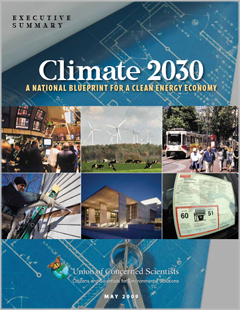Reducing oil dependence. Strengthening energy security. Creating jobs. Tackling global warming. Addressing air pollution. Improving our health. The United States has many reasons to make the transition to a clean energy economy. What we need is a comprehensive set of smart policies to jump-start this transition without delay and maximize the benefits to our environment and economy.
To help avoid the most dangerous consequences of climate change, ranging from extreme heat, droughts, and storms to acidifying oceans and rising sea levels, the United States must play a lead role and begin to cut its heat-trapping emissions today—and aim for at least an 80 percent drop from 2005 levels by 2050. Blueprint policies lower U.S. heat-trapping emissions to meet a cap set at 26 percent below 2005 levels in 2020, and 56 percent below 2005 levels in 2030.
The nation achieves these deep cuts in carbon emissions while saving consumers and businesses $464 billion annually by 2030. The Blueprint also builds $1.7 trillion in net cumulative savings between 2010 and 2030. Blueprint policies stimulate significant consumer, business, and government investment in new technologies and measures by 2030. The resulting savings on energy bills from reductions in electricity and fuel use more than offset the costs of these additional investments. The result is net annual savings for households, vehicle owners, businesses, and industries of $255 billion by 2030.
Under the Blueprint, every region of the country stands to save billions. Households and businesses—even in coal-dependent regions—will share in these savings.




